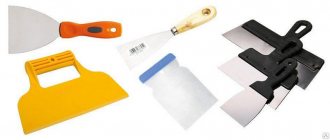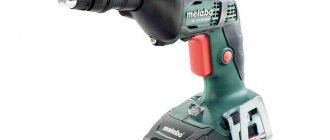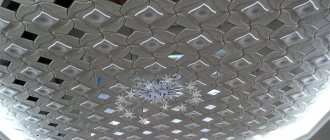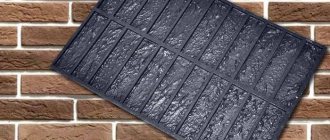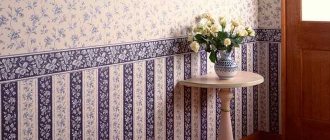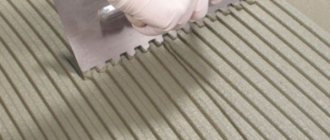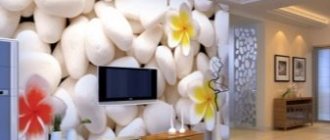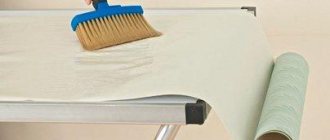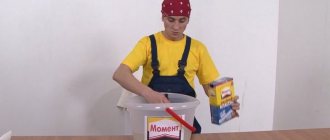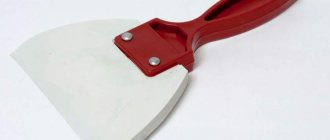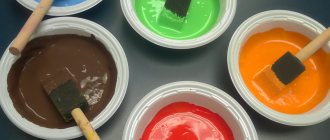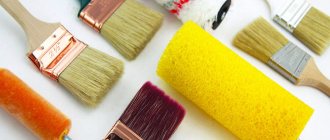The time when we used rags from retired T-shirts and various other rags in the process of wallpapering is long over. As practice shows, this method of smoothing wallpaper is completely ineffective and quite labor-intensive. Progress did not stand still. The place of the rag was firmly occupied by a wallpaper spatula. Using this tool, it is much more convenient and faster to smooth out the wallpaper, expel the air from under it and securely fasten the material to the wall.
Despite the fact that this device was born much later than wallpaper itself came into our lives, the spatula gained popularity among professionals and became their indispensable companion and assistant in their work. Spatulas are used for various types of repair, construction and finishing work. They are used to seal cracks and seams on walls, apply thick adhesive mixtures, prime and clean the surface and, of course, quickly and efficiently glue wallpaper.
Variety of shapes and sizes
Wallpaper spatula can be different. There are more than five types of such tools that are used when working with wallpaper. In stores you can see spatulas of various shapes and configurations, made from various materials. In order for the work to be completed more efficiently and, if possible, quickly, some nuances and factors in choosing a tool should be taken into account. We will look at them today.
We distinguish different types
When carrying out repairs, it is important not only the choice of materials, as well as strict adherence to the instructions, but also the correct selection of tools. A spatula for liquid wallpaper, despite its apparent secondary nature in the overall process of decorating a room's interior, is an important tool. What kind of wallpaper spatula should there be, what types are there and how to choose the right one: all these questions will be discussed in this article, which is a logical continuation of the materials “How to apply liquid wallpaper on drywall: learning how to prepare and apply” and “Liquid silk wallpaper: an alternative solution for the walls of the room.”
The classic and most common version of the wallpaper spatula
First of all, it is necessary to say that all spatulas, according to their functional purpose, are divided into 2 types:
- Pressing (leveling), which is designed to smooth and level the surface of the wallpaper after gluing. This helps prevent bubbles and creases from forming. Also known as plastic wallpaper comb.
- A spatula for liquid wallpaper, a photo of which you can see in the examples in this article. It is intended for applying liquid wallpaper to the working surface of walls and interior partitions in an apartment.
Thus, when describing these two tools, it is always necessary to clarify what exactly we are talking about, since both of them are radically different not only in the manufacturing scheme and materials used, but also in what tasks they are designed to perform.
Various tool options
As for the wallpaper pressing spatula, it should be noted that it appeared not so long ago. Until relatively recently, most people simply used a dry cloth, with which they smoothed out the wallpaper after it was glued to the wall. Strange as it may seem, some continue to use this outdated, “old-fashioned” method, which, without any doubt, not only takes more effort and time, but is also less effective.
Classic pressure spatula
This tool is almost exactly like a regular putty tool. The only difference is that this wallpaper spatula is made not of metal, but of plastic. It is very convenient for working with large areas and large-scale surfaces. With its help, you can easily expel excess air that is trapped between the wall and wallpaper or get rid of excess glue. This spatula can also be used as a ruler when it is necessary to cut the wallpaper evenly.
This type is also called a pressure spatula. It presses the wallpaper even in hard-to-reach places. Experts say that with the help of such a tool it is very easy to join one sheet of wallpaper to another. This spatula is used for non-woven, paper and vinyl wallpaper. The clamping option can be rectangular or feather-shaped.
Experts advise that before purchasing a wallpapering tool, it is very important to evaluate its quality. What should the pressure spatula be like? The cost here is not as important as it seems to many beginners who are trying to choose a cheaper option. In this matter, the most important thing is quality. It is recommended to pay your attention to this first.
A good classic pressure spatula must have a flat surface. The quality of the plastic from which it is made plays an important role. Try to carefully look at the working surface of the tool before purchasing. It should not have any roughness or any other manufacturing defects. By purchasing such a low-quality spatula, you can easily damage expensive finishing materials. The repair process in this case, you see, will not bring any pleasure or joy from the result.
Spatula for liquid wallpaper - which one is suitable?
Many people even apply liquid wallpaper with a spatula.
Since liquid wallpaper is an unusual type of coating, the spatulas that we discussed above are completely unsuitable for applying it. However, a spatula for liquid wallpaper exists and now we will talk more about it. Also read about how to apply warm plaster.
So, if you are going to apply liquid wallpaper, you can stock up on the following tools:
- You are unlikely to be able to purchase a standard spatula for liquid wallpaper. That is why it is much easier to buy a simple putty spatula, the width of which is 250-300 mm. This size is good in the sense that the work can be completed quite quickly. The leveling procedure will not be particularly complicated - which cannot be said about wider spatulas;
- Regardless of what device you decide to use, you definitely cannot do without a narrow spatula 85-100 mm wide. After all, it is with this tool that the mass is applied and distributed onto the basic working spatulas;
- To distribute the composition on the wall and perform leveling, manufacturers advise using a special plastic trowel. With this tool you will achieve the best result, and the effort and time spent will be minimal.
The working process here is quite simple: a small amount of liquid wallpaper is applied to the trowel using a narrow spatula. Next, it is simply distributed in an even layer over the surface of the wall.
We invite you to watch the video: a spatula for liquid wallpaper. Perhaps this particular video will give an understanding of how to work with liquid wallpaper correctly and as conveniently as possible
.
Applying liquid wallpaper correctly
Wallpaper is applied using a spatula with high quality and accuracy
We have already spoken in detail about liquid wallpaper, but within the framework of this material we should also mention such finishing. What is liquid wallpaper? This is a dry mixture of dyes, glue, and usually contains some natural raw materials: mica, algae, wood chips.
Since we are not looking at the usual rolls of canvas, it is very easy to get confused: someone says that covering a wall with liquid wallpaper on your own is not difficult, but very difficult. But in practice, no difficulties usually arise - everyone copes.
What is important to remember when working with such material?
There are few rules, but they are there:
- First of all, if you decide to apply liquid wallpaper to the wall (with a spatula or something else), carefully read the instructions on the packaging for the material. This will definitely help you avoid the most annoying mistakes;
- You need tools to cope with the task: a bucket, a soil roller, a plastic spatula, a basin.
Please note: when working with liquid wallpaper, you should use a spatula made exclusively of plastic. Any professional finishing specialist will confirm this to you.
Plastic spatulas are not uncommon today
Before you start applying liquid wallpaper, the surface of the wall must be properly prepared. Usually, putty is applied, as well as a primer - as in many other cases, this is an important stage of work before applying liquid wallpaper.
This is not difficult to explain: to apply liquid wallpaper, a prerequisite is a surface that is perfectly flat. That is, only such walls can be coated with finishing material. That is why, in any case, the surface must be primed; in some cases, the walls are also strengthened: especially for this purpose, they are pre-painted with water-dispersion paint.
A good solution: select pre-painting paint of the same tone as the future wallpaper.
What else you should know about the process:
- When applying liquid wallpaper, it does not matter at all what material the walls in your home are made of. The finish will look great on both concrete and brickwork. Even today, liquid wallpaper is often applied to drywall - and no one regrets it;
- Preparation is required to prepare this finish for application. On average, the process takes about 12 hours (it all depends on who is the manufacturer of your liquid wallpaper);
- To dilute the mixture, you need warm water. The proportions indicated on the packaging must be strictly observed. Kneading wallpaper is done by hand;
- Most often, one bag of material is designed for only five square meters of area. There are three proven methods for applying liquid wallpaper to the wall; now we will consider them in detail.
Despite its simplicity, the tool actually helps in working with wallpaper
Application methods:
Applying liquid wallpaper is not difficult - you can start work from almost anywhere on the wall: from a corner or from the center, from a window or door. Since this coating has no seams, the task becomes not so difficult.
Your wallpaper will lie as smoothly as if you were laying a carpet on the wall. If the renovation is carried out in a new building, you don’t have to wait for the house to shrink. It’s just that even if there is severe shrinkage, liquid wallpaper will not change its appearance in any way: among the advantages of the material, all manufacturers note its plasticity.
1 way:
- Do not forget that you need to apply liquid wallpaper to the wall in one go: from corner to corner. Thanks to this approach, the surface will be as uniform and even as possible. In order for each element of the wallpaper to be located evenly on the surface, it is imperative to knead exactly one bag - no less;
- A good option: apply liquid wallpaper using a plastic trowel. You will need a spatula when applying. If there is none, you can always use a paint roller. It is recommended to constantly change the angle of the spatula relative to the wall. The larger the angle, the thinner the layer of wallpaper already applied will be.
Tools ready to go
A thin layer is a sign that the work of applying liquid wallpaper with a spatula was done at a professional level. The standard thickness of 1 layer varies from 1 to 3 mm. However, if this is too little, then a layer of up to 10 mm can easily be maintained on the wall (however, the consumption will be very large and, accordingly, financial expenses too).
Method 2:
- If you want the wall to be as textured as possible, when applying liquid wallpaper, do not press too hard on the spatula. The material is easy to apply - you will see for yourself. The most important thing here is that the entire surface of the wall be treated;
- If you roll wallpaper with a roller, it is done in much the same way as when applying too thick paint. And to make the wallpaper pattern more perfect, 6 hours after application you can always walk over the surface with a roller that has a ribbed surface. The instrument itself is pre-wetted in water;
- Liquid wallpaper is applied to the ceiling in the same way as on the walls. The most important thing here is that the surface is perfectly flat. If you cannot achieve evenness with a primer, it’s time to think about using drywall;
- It takes no more than 48 hours for the wallpaper to dry. And if the room is warm, 12 hours will be enough. The lower critical temperature point for applying wallpaper is +10 degrees. That is, if it is cooler here, it is not recommended to apply such material.
If you want the wallpaper to dry efficiently, it is important to ventilate the room well. Thanks to this, all excess moisture will evaporate.
3 way:
This is what the tool might look like
You should know that you cannot wash liquid wallpaper with a damp cloth. If you want to clean the surface, use a vacuum cleaner or dry cloth. However, if you use water, you can easily clean off dirty or worn areas on the surface. Thus, if you need to get rid of finishing material somewhere: wet a rag with water and wash off the wallpaper - it’s very simple.
Notched trowel
Most often, this tool is used in cases where it is necessary to apply an even layer of adhesive mixture to the walls. The spatula is called a serrated spatula because there are teeth along the perimeter of the blade. They can be of different sizes and lengths, located at different distances from each other. Everything will depend on the type of work in which this tool takes part. There are models on sale, both with and without a handle.
Thanks to its use, you will not have to worry that the adhesive composition is unevenly distributed in some places. A notched spatula is recommended for use when the work involves expensive imported adhesive compositions and the most economical consumption is required.
Shape of spatulas
The shape of commercially available products varies significantly. This is due to the fact that each individual option is suitable for a specific type of finishing work. As for the flat trapezoidal and pointed element, it is better to use it for surface treatment with mixtures. If we talk about plastic varieties of products in the shape of a semicircle or feather, then they are great for rolled materials. If we are talking about rectangular elements, then it is better to choose them for processing the coating with a special decorative finish. It is also worth noting spatulas with a decorative structure, since they are used mainly for applying decorations in the form of structural plaster.
Rubber
But not a single set of professional tools can do without such an item as a rubber spatula. This model is made of soft rubber or elastic silicone and is very comfortable to use. Used for grouting tile joints, when working with sealant, and also for smoothing wallpaper joints.
Thanks to the small width of the working surface (from forty to seventy millimeters), the rubber spatula fits easily in the hand, put in a pocket and stored in a bag with tools. It is pliable and easy to care for. Of course, it costs a little more than some other options, but it also lasts an order of magnitude longer.
What else do you need to know
Here are additional characteristics according to which you can choose one or another wallpaper spatula:
- If we talk about plastic products, then we should choose, so to speak, the “golden mean”. How exactly does this quality manifest itself? Rather, the point is that such a spatula should neither be too soft nor particularly hard (so as not to cause damage to the wallpaper). Such a fairly elastic tool is ideal for performing most of the work for which it is intended.
- It is imperative that you ensure that the product you purchase is of high quality. Therefore, before you buy this or that wallpaper spatula, make sure that it is well made and does not have visible defects.
- The criterion related to the previous paragraph tells us that it is advisable to select tools that are made by reliable manufacturers that have earned recognition from professionals.
Tool for working with liquid wallpaper
Recently, wall treatment with decorative plaster has become increasingly popular. People also often call it liquid wallpaper. Which spatula to choose for liquid wallpaper?
Let’s say right away that the tools described above are not suitable for such work. There is a special type for working with such finishing materials. It's called "falcon". The advantage of this tool is that it has four working surfaces. The length of the spatula is twenty to twenty-five centimeters.
Most often it has a rectangular shape, but there are also trapezoidal spatulas for working with liquid wallpaper. The handle on it is located perpendicular to the working surface, which increases convenience. The tool for liquid wallpaper can work as a presser, smoother or as a spatula for rolling wallpaper. With its help, seams and corners are processed.
Such a spatula is usually made of plexiglass or metal. It does not injure the surface at all. They can work with Venetian plaster and any capricious glossy surfaces.
Workflow Features
For excellent results, follow a few basic recommendations:
- Leveling is done from the middle to the edges using gentle movements with moderate pressure - if you press too hard, you will most likely damage the surface of the wallpaper or even tear it. The direction of movement is from top to bottom, while trying not to miss a single piece of the surface.
This is how the workflow goes:
- Pay special attention to the joints and corners of the room. The joints should be pressed tightly and well lubricated with glue. As for the corners, there is a greater danger of damage to the coating than anywhere else, due to the fact that the wallpaper has been softened by the glue. To minimize the likelihood of damage, work should be done within the time intervals recommended by the instructions on the glue package.
Advice! Remember that if your surface is imperfect and has depressions or protrusions, the spatula can damage the wallpaper in these places. Therefore, on curved walls it is better to use simple rags.
Which spatula to choose
The type of tool will directly depend on the work it must handle. If large-scale projects are coming up, then you should purchase a wide flat spatula with a working blade width of 20-30 centimeters. Experts say that it is never a bad idea to buy several spatulas of the same type, but of different sizes. For example, it is convenient for little ones to measure and dose the adhesive mixture. They can also apply the mixture onto a large spatula, which, in turn, will distribute it over the working surface of the wall.
When purchasing a spatula for working with wallpaper, it is very important to consider the fact of convenience. Try how the tool fits in your hand, whether the handle is comfortable, and whether it does not slip out. It is also very important to pay attention to the weight of the spatula. A tool that is too heavy will be inconvenient to use. Don’t be shy, “try” working with a spatula right in the store. Simulate the movements of the instrument. This will make it possible to understand the “weight category”, how quickly the hand will get tired when working with it and whether a callus will rub after prolonged use.
Pay attention to such an indicator as the softness or, conversely, hardness of the instrument. A spatula that is too soft will be completely useless in the work, reducing all efforts to nothing. You should not purchase an option that is too hard. In the process, it may simply break in your hands from strong pressure. Try to find the “golden mean” on the shelves of construction stores.
And the last piece of advice that professionals give to beginners. Never skimp on purchasing a quality tool and try to have several types in stock. Depending on the type of tool, its size, the materials from which it is made, its cost will also vary. For example, a rubber spatula - the price varies from 16 to 50 rubles; classic - price from 75 to 750 rubles (depending on the manufacturer); gear - the price can start from 80 and reach 170-250 rubles.
Even the simplest and most modest repair will require the use of at least three options. And if they are not in stock, then you will have to return to the “origins” - old rags. Why do you need this?
What to look for when choosing a tool
In the retail chain you can find several types of similar devices, which differ in configuration, material of manufacture and manufacturing plant. In order for the work to proceed in the best possible way, several main factors should be taken into account, which we will consider.
Fixture configuration
The shape of the product is a factor that is not always taken into account, however, it is of great importance, since ease of use directly depends on it.
Today, several main types of devices are sold:
- The classic form of a spatula - the tool resembles a regular putty spatula with the only difference that it is completely plastic . This is an excellent option when working with heavy coatings and large finishing areas. This configuration allows you to quickly expel air and excess glue even from under wide rolls, but there is one drawback - it is inconvenient to use such a spatula in corners.
Classic-shaped products are good when working with dense materials
- A trapezoid spatula is usually small in size, making it easy to store . This device is convenient to use for small amounts of work; it allows you to level both flat surfaces and corners. This type of product can be used with almost any type of wallpaper, and its price is quite affordable, which is an additional reason for its popularity.
Convenient and compact device to facilitate the process of wallpapering
- A universal spatula or, as experts call it, a “shark fin” is used most often by developers . This group of devices is very easy to work with, both on flat surfaces and in corners; they can also be used to apply wallpaper glue to paper or a wall. As practice has shown, for those who do not have experience in carrying out such work with their own hands, it is most convenient to work with just such a tool.
Great device for work
- The “boat” pressure spatula is less common than other options, but many people like this particular type of tool due to the ease of grip of the device and the semicircular shape, thanks to which it is possible to smooth out hard-to-reach areas very well . Otherwise, the weapon is no different from other analogues.
The boat-shaped wallpaper spatula is very comfortable to hold.
Advice! The main criterion for choosing one option or another should be convenience - hold the tool in your hand and, all other things being equal, buy the one that is more convenient for you.
Other product characteristics
But not only the form is the criterion by which you need to choose a specific option; there are also other factors:
- Quality of the tool: the surface must be smooth without flaws or sagging formed during the casting of the product. Particular attention should be paid to the working edge - it should be of uniform thickness along the entire length without any damage or cracks.
- It is best when the plastic used for production is moderately elastic - when pressed, it should bend, but not be too soft. It is also undesirable to purchase a very rigid option that practically does not bend - it is very easy for them to damage the wallpaper during operation.
- Another factor that is worth considering is the manufacturer of the product. Very often, such devices quickly fail - they crack, deform or even break, although it would seem that they are not subjected to heavy loads. Most often, the reason for this is the low quality of raw materials, so there is no need to save money; even the most expensive options are quite affordable.
